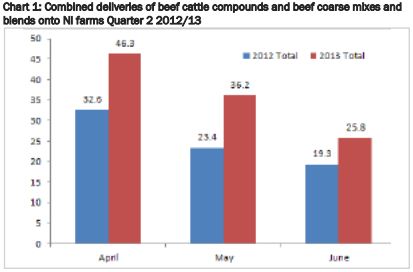



LMC: Concentrate Usage Up 24 Per Cent After Late Spring
NORTHERN IRELAND - Poor spring weather compounded forage shortages, delaying turnout time and forcing producers to buy more feed.According to the latest Northern Ireland Animal Feed Statistics from DARD for the period April-June 2013 have indicated a 24 per cent increase in the amount of concentrates used by cattle and sheep producers when compared to the corresponding period in 2012, write analysts at the Livestock and Meat Commission.
This increase in concentrate usage was in response to one of the most difficult springs experienced by beef and sheep producers as a result of fodder shortages, the poor weather conditions and the late grass growth delaying turn out for many producers.
Combined with increasing concentrate costs this will have placed cost pressure on many producers however this will have been off set to some extent at least by higher farmgate prices achieved by those who have sold stock.
Concentrate usage in beef production has shown a notable increase year on year. The total amount of beef cattle compounds and beef mixes and blends purchased increased from 74.7 thousand tonnes in Quarter 2 2012 to 108.2 thousand tonnes in Quarter 2 2013.
LMC analysts say this accounts for a 45 per cent increase year on year as displayed in Chart 1. Meanwhile the quantity of sheep concentrates purchased increased from 15.8 thousand tonne in Quarter 2 2012 to 23.7 thousand tonnes in Quarter 2 2013.
This increase by 7.9 thousand tonnes represents a 50 per cent increase in concentrate usage year on year. While some of this increase can be attributed to difficulties in production there were also some reports from industry that the feed concentrates available to producers were of a lower quality than previous years.
The poor harvest conditions in 2012 resulted in a decline in the quality of the cereals used in animal feed production which will have impacted on animal performance as a result. In some cases producers may have had to increase concentrate feeding levels to maintain animal performance and to get cattle and sheep fit for slaughter.
TheCattleSite News Desk



